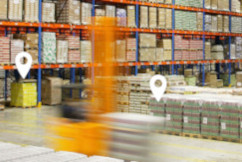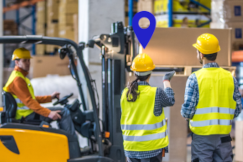Background
NGK Ceramics based in Mooresville, is a subsidiary of NGK INSULATORS LTD.,
a leading global ceramic technology company headquartered in Nagoya, Japan.
The honeycomb ceramic that is produced by NGK Ceramics is an indispensable part for the catalytic converters of cars.
The US manufacturing facility covers more than 46.000m² and is in operation 365 days a year, 24 hours a day.
Challenge
Over the years, NGK grew rapidly and had to find a way to increase the capacity and
efficiency of the North Carolina industrial plant in order to keep up with market demand.
First of all, ASRS (Automated Storage and Retrieval Systems) and AGVs (Automated Guided Vehicles) were implemented in the logistics to handle
pallets and materials in the shop floor without human intervention. While this addressed the lack of storage space, during production peaks, the pallets that transported both
raw materials and semi-finished products were temporarily stored all around the factory introducing a new type of issue: the additional time it took to find and move pallets
from one production stage to another.
In addition to this, a complete inventory of the plant was required at least once a year to verify all materials being stored in the facility, but not yet shipped or sold.
This activity was very time-consuming, as it used to last several days and cause a slowdown (or interruption) of production.
Solution
To deal with these problems, the company decided to test Real Time Locating System (RTLS) solutions: thanks to this technology,
the location of each pallet would be tracked continuously, and the data would be synchronized with NGK's material requirements planning systems. The traceability
of pallets provides a real-time view of their location within the industrial plant, thanks to the creation of a Digital Twin.
The chosen solution involves the use of the BlueUp Card tag ,
the application of the ThinkIN location intelligence solution , and the
Quuppa Intelligent Locating System .
This solution was chosen for three main reasons:
• the ability to configure tracking accuracy as needed. For example, in areas such as the warehouse,
where the number of pallets is high, an accuracy of less than one meter is required to easily identify a specific pallet,
while an accuracy of 10 meters is sufficient in corridors or transit areas;
• the cost of the infrastructure: this proved to be the most convenient solution as there was a right balance between the number of
antennas required to cover the facility and their costs;
• finally, a ready-to-use solution was required, able to support active monitoring services, both concerning the platform and the RTLS
infrastructure. Any device or software component implemented in the structure needed to be monitored, with notifications sent in case of anomalies in the
system. This includes the battery status of the devices/tags used to track the pallets.
95 antennas were installed and the tag that has been chosen was the
BlueUp Quuppa Card thanks to its shape (which aligns optimally
with the process of production), to the thin and long-lasting battery (4 years of life without replacement) and for full support of Quuppa protocol (Quuppa Approved).
The pallets, which transport products or semi-finished products, are identified through their Product Travel Ticket (PTT), which contains all
the information on the type of product made, together with information on the production phase (e.g. forming line, baking, etc.).
At the beginning of the production process, an RTLS TAG is associated with the Travel Ticket of the pallet via a mobile application running on a scanner. The application
allows scanning both the QR code on the PTT and the QR code on the TAG. This association creates a digital twin of the pallet, which is now tracked in
real time throughout the production process.
Additionally, plant-wide views allow staff to monitor the status of pallets throughout the facility, maintaining an up-to-date inventory of all pallets
stored or handled. Besides asset search and inventory management, additional services are provided through the ThinkIN platform, such as process monitoring services,
with activation of alerts if the pallet moves into prohibited areas or wrong production steps.
Results
BlueUp tags, combined with ThinkIN and Quuppa technologies,
have enabled NGK to digitize the production area by recreating the plant on screens accessible to all workers.
This is how NGK Ceramics has reduced the time spent searching for pallets and the time spent on annual inventories,
reducing costs and increasing efficiency.
In addition to this, a complete inventory of the plant was required at least once a year to verify all materials being stored in the facility, but not yet shipped or sold. This activity was very time-consuming, as it used to last several days and cause a slowdown (or interruption) of production.
This solution was chosen for three main reasons:
• the ability to configure tracking accuracy as needed. For example, in areas such as the warehouse, where the number of pallets is high, an accuracy of less than one meter is required to easily identify a specific pallet, while an accuracy of 10 meters is sufficient in corridors or transit areas;
• the cost of the infrastructure: this proved to be the most convenient solution as there was a right balance between the number of antennas required to cover the facility and their costs;
• finally, a ready-to-use solution was required, able to support active monitoring services, both concerning the platform and the RTLS infrastructure. Any device or software component implemented in the structure needed to be monitored, with notifications sent in case of anomalies in the system. This includes the battery status of the devices/tags used to track the pallets.
The pallets, which transport products or semi-finished products, are identified through their Product Travel Ticket (PTT), which contains all the information on the type of product made, together with information on the production phase (e.g. forming line, baking, etc.).
At the beginning of the production process, an RTLS TAG is associated with the Travel Ticket of the pallet via a mobile application running on a scanner. The application allows scanning both the QR code on the PTT and the QR code on the TAG. This association creates a digital twin of the pallet, which is now tracked in real time throughout the production process.
Additionally, plant-wide views allow staff to monitor the status of pallets throughout the facility, maintaining an up-to-date inventory of all pallets stored or handled. Besides asset search and inventory management, additional services are provided through the ThinkIN platform, such as process monitoring services, with activation of alerts if the pallet moves into prohibited areas or wrong production steps.
Also check out the case study by NGK published by ThinkIN
Related content





